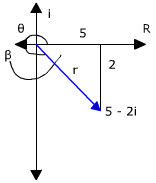Polar Form of a Complex Number

Conversion Formula for rectangular to polar x + yi = r(cos θ + i sin θ)
-
Example 1: convert 5 + 2i to polar form
Step 1: sketch a graph


Step 2: find r using the Pythagorean Theorem
r2 = x2 + y2
r =
r =
r =
r =
Step 3: Using Trigonometry find θ
Recall that
tan θ =
therefore
tan θ =
to find θ θ =
to find θ θ =
Step 4: write in polar form using the conversion formula
5 + 2i = 5.4 (cos 21.8° + i sin 21.8°)
- Example 2: convert 5 - 2i to polar form
Step 1: sketch a graph

Step 2: find r using the Pythagorean Theorem
r2 = x2 + y2
r =
r =
r =
r =
Step 3: Using Trigonometry find θ
Because the complex number is in Quadrant IV and θ is the angle from the positive horizontal axis to the vector: θ = 360° - β
Recall that tan β
=
therefore tan β
=
to find β β =
θ = 360° - β θ = 360° - 21.8° = 338.2°
to find β β =
θ = 360° - β θ = 360° - 21.8° = 338.2°
Step 4: write in polar form using the conversion formula
5 - 2i = 5.4 (cos 338.2° + i sin 338.2°)
To write a complex number in polar form: (1) draw a sketch labeling all parts (2) use the Pythagorean theorem to find the length of r (3) Find θ by using trigonometry and (4) use the formula to write in polar form.
To link to this Polar Form of a Complex Number page, copy the following code to your site:
